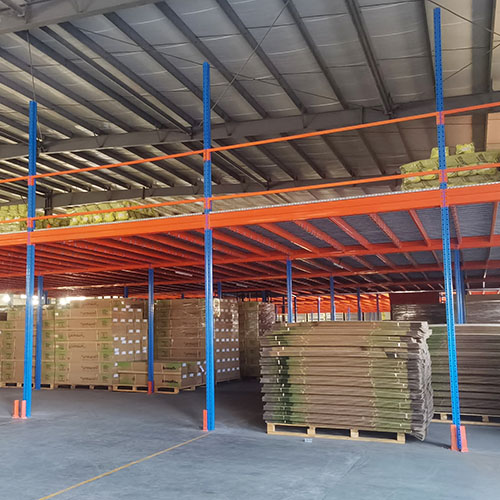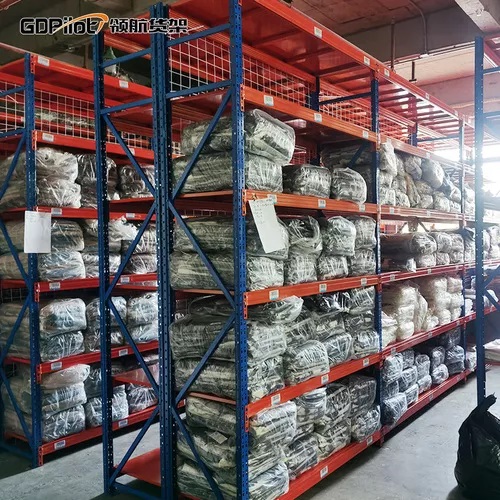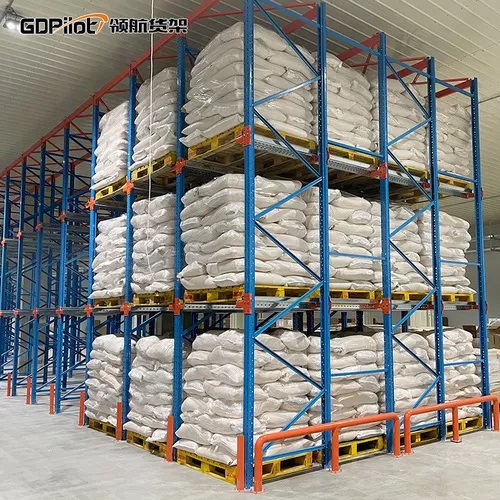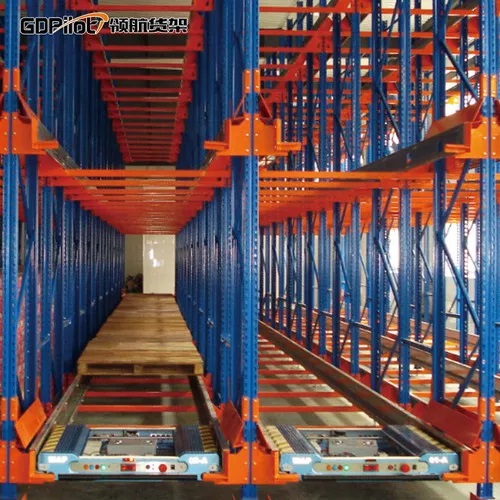Mezzanine Racks: The "Space Multiplier" for Warehouses
In modern warehouses where land costs are soaring and horizontal space is increasingly tight, making full use of vertical height has become a core strategy for enterprises to reduce costs and improve efficiency. Among various space-saving solutions, mezzanine racks (also known as mezzanine floors or mezzanine platforms) stand out—it is not just a simple storage rack, but a "customizable second floor" built in the air. It enables warehouses to double their usable area without expanding the building.
1. What Are Mezzanine Racks?
Mezzanine racks are semi-permanent multi-level storage systems constructed by combining steel frames, floor panels, and auxiliary structures (such as stairs, handrails, and elevators). Installed between the ground and the warehouse ceiling, they divide the original single-layer vertical space into 2-3 independent functional layers.
Their biggest features are flexibility and adaptability:
• Unlike fixed buildings, they can be disassembled, moved, or expanded according to changes in warehouse needs.
• The upper layer can be used for storing light goods, setting up offices or sorting stations, while the lower layer can hold heavy-duty racks or large equipment—realizing "one space, two uses".
2. Why Choose Mezzanine Racks?
For warehouses troubled by space constraints, mezzanine racks solve pain points in ways that traditional racks cannot:
• Cost-effective space expansion: The cost of building a mezzanine is only 30%-50% of expanding the warehouse area or relocating. It avoids high costs of land acquisition and new construction, and can be put into use within 2-4 weeks.
• No wasted vertical space: Most warehouses have a ceiling height of 6-12 meters, but only 3-4 meters are used for ground storage. Mezzanine racks tap into the "idle overhead space", increasing the total usable area by 80%-120%.
• Multi-scenario adaptability: Suitable for storing light to medium-weight goods (usually 100-500kg per square meter), such as cartons of daily necessities, electronic components, and spare parts; they can also meet non-storage needs, such as building temporary offices or quality inspection areas.
• Safety and compliance: Made of high-strength steel, they meet international load-bearing standards; equipped with anti-slip floors, fire-resistant materials, and emergency exits, they fully comply with warehouse safety regulations.
3. Typical Application Scenarios: Advantageous Fields of Mezzanine Racks
• E-commerce and retail warehouses: The upper layer stores slow-moving goods (e.g., seasonal products), and the lower layer handles fast-moving consumer goods (e.g., daily bestsellers). This design separates storage and picking areas, reduces forklift traffic, and improves order processing speed.
• Manufacturing factories: Used to store semi-finished products or spare parts; the upper layer can be set up as workshop offices or material distribution stations, shortening the distance between the storage area and the production line.
• Third-party logistics (3PL) centers: Facing frequent changes in customer needs, mezzanine racks can be quickly adjusted to store various goods from small parcels to medium-sized cartons, enhancing the warehouse’s flexibility in serving multiple customers.
• Cold chain warehouses: Special cold-resistant mezzanines (equipped with anti-corrosion steel and anti-frost floors) make use of the vertical space in cold storage, reducing the need for additional refrigeration equipment and lowering energy consumption.
4. Key Considerations for Choosing Mezzanine Racks
1. Warehouse height and floor load-bearing capacity: First, confirm the clear height of the warehouse (at least 4.5 meters for a 2-layer mezzanine), and check the floor load-bearing capacity (usually ≥5kN/m²) to ensure it can support the weight of the mezzanine and goods.
2. Cargo characteristics: Calculate the weight, size, and access frequency of goods. Heavier goods or those accessed frequently should be placed on the lower layer, while lighter and slow-moving goods on the upper layer.
3. Access and safety equipment: Match the mezzanine with suitable access tools—use stairs or small elevators for manual picking, and cargo lifts or conveyors for bulk goods; install handrails (≥1.1 meters high) and anti-fall nets on the upper layer.
4. Future expansion needs: Choose modular mezzanine systems, such as those with detachable steel frames, so that you can add layers or expand the area at any time when the warehouse’s storage demand grows.
5. Daily Maintenance Tips to Extend Service Life
A well-maintained mezzanine rack can have a service life of 15-20 years. Just follow these simple but effective tips:
• Monthly visual inspections: Check if the bolts on the steel frame are loose, if there are cracks on the floor panels, and if the handrails are rusted. Tighten or replace damaged parts immediately.
• Abide by load-bearing limits: Clearly mark the maximum load per square meter on the mezzanine, and prohibit overloading or placing heavy objects on the edge of the floor.
• Safety operation training: Train employees to prohibit the use of forklifts or pallet trucks on the upper layer of the mezzanine (except for specialized heavy-duty mezzanines), and prohibit leaning ladders or tools against the mezzanine handrails.
Mezzanine racks represent a "smart upgrade" in warehouse design—they turn idle vertical space from a "ceiling" into a profitable asset. Whether you are an e-commerce seller troubled by surging orders or a manufacturer looking to optimize production processes, a well-designed mezzanine system can help you achieve more value with less space.






